HEAD’S HEAVY DUTY BRAKING SYSTEM GAINING STEAM
Fri, 2010-06-25 15:00
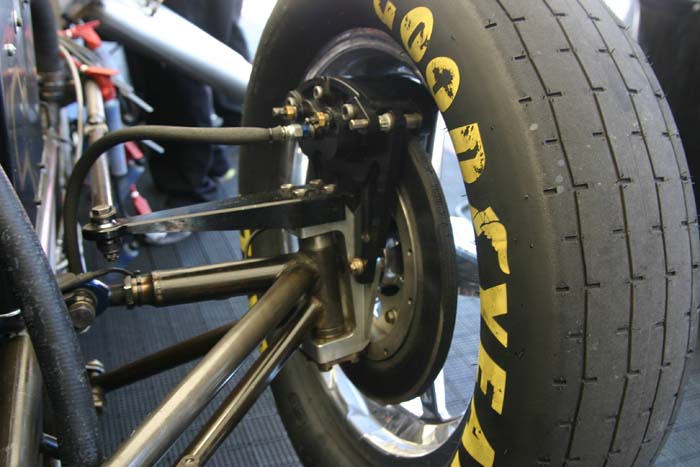 Jim Head is back in his laboratory conjuring up ideas, again.
Jim Head is back in his laboratory conjuring up ideas, again. The longtime drag racing innovator used to seek performance gains from his inventions but in the last half decade or so, his agenda has changed. He’s all about safety.
The focus of Head’s latest innovation is in getting the nitro cars stopped quicker and safer. While the outspoken advocate of 1,000 foot nitro racing believes shortening the race course has made drag racing on the 300 mph level safer than ever and easier to stop the cars, the revised course is not the end all to making nitro racing safer.

Jim Head is back in his laboratory conjuring up ideas, again.
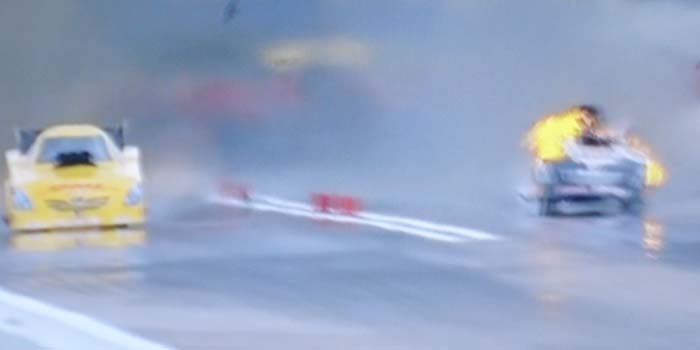
Shortly after this photo, Head's wounded race car crossed the centerline and made contact with the wheelie bars on Jeff Arend's Funny Car. Head contends the front brakes enabled him to slow his car to 20 mph when the contact occurred. [Photo via ESPN2]
The focus of Head’s latest innovation is in getting the nitro cars stopped quicker and safer. While the outspoken advocate of 1,000 foot nitro racing believes shortening the race course has made drag racing on the 300 mph level safer than ever and easier to stop the cars, the revised course is not the end all to making nitro racing safer.
An ounce of prevention is worth a pound of cure, and for Head, the bulky front brakes on his Toyota Funny Car averted a potential disaster last month in Topeka, Ks.
Head exploded an engine, blowing the body off and in the midst of the engine belching fire, he got lost. He was blinded momentarily by the fire. Instinctively he got on the brakes and the parachute automatically deployed via the Electrimotion system, yet his car drifted over the center line and into Jeff Arend’s lane.
While the majority of the Funny Car teams use rear brakes primarily to stop, Head said it was his front brakes which made the difference as he merely tapped Arend’s wheelie bars. Without those brakes Head feels the outcome could have been much worse, because his rear brakes had become ineffective as they became coated in the oil spewing from his exploding engine.
“I hit him at probably 20 miles per hour,” Head confirmed. “If I hadn’t have had those front brakes to slow me, no telling what might have happened. I could have run up the back of that car and landed on his roof. Can you imagine being a driver and having an engine over your head and leaking oil?”
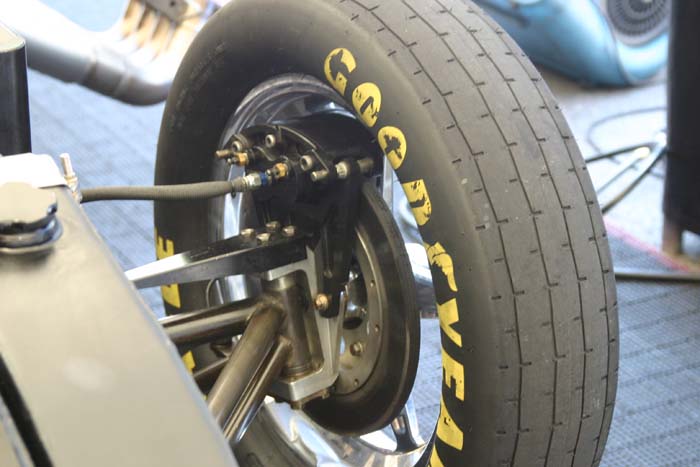
A comparison of Head's braking system [above] and the standard version used on the majority of nitro Funny Cars. Head’s heavy-duty brakes are an inch larger in diameter than the standard and the key to their effectiveness has been the double-piston design. Head believes the unit has tripled the stopping force provided over today’s standard unit.
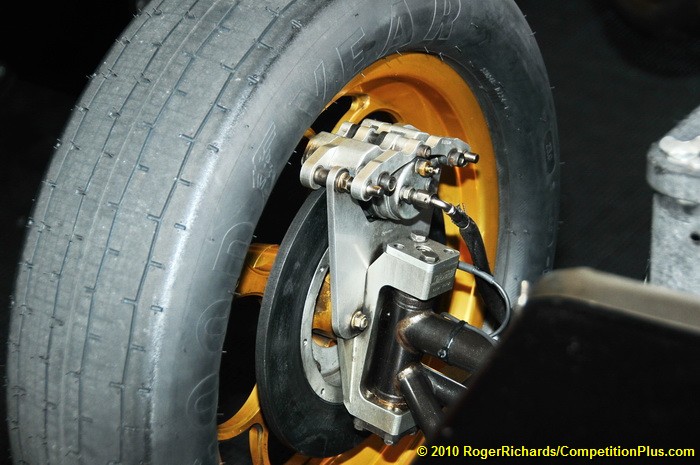

Head’s heavy-duty brakes are an inch larger in diameter than the standard and the key to their effectiveness has been the double-piston design. Head believes the unit has tripled the stopping force provided over today’s standard unit.
Head believes when you get into a situation similar to what he experienced in Topeka or have parachute trouble at one of the shorter tracks, the ability to stop could easily represent the difference between life and death.
“I can skid the tires, I have proven that,” said Head. “We can put so much stopping power on the front of the car, clearly where you get most of your stopping power, that when we first did it, it was trying to tear the spindle off. We actually had to go back and reinforce the a-arm system.”
Head believes that while a double parachute system helps the deceleration greatly, it cannot be depended on as the last word in getting stopped.
“If I’ve got a choice of stopping between my parachute and front brakes, I’m taking the brakes,” Head said, with a stern look on his face.
In this day and age of performance and delivery, the downside to the brakes is the added weight. Head wonders aloud what good having a lighter car will present a driver when they get in trouble.
“At least sixty to seventy pounds on my car is made up of safety equipment,” Head confirmed. “I am willing to give up weight in the name of safety. How could you not do that? If you run off the end of the track and get hurt bad because you couldn’t stop, could you really look your wife and kids in the eyes and say, ‘hey, but at least I had a lighter car.”
Fellow Funny Car driver Del Worsham was competing in Englishtown and moments after Neal Parker’s fatal crash during Friday qualifying at the NHRA SuperNationals, walked over to borrow a set of Head’s front brakes. Parker was killed when his Alcohol Funny Car went into the containment system following a high speed run. A cause of death has not been released yet.
“I was looking to do something different,” admitted Worsham. “The track was short, there had already been some trouble … not that the front brakes would have made a difference in what happened there. If there’s a better way out there to get us stopped, and there’s no downside, performance wise, then it should be on this car, bottom line. I really don’t see any reason why we shouldn’t run them.”
Worsham and his team were unable to properly outfit their car with the front brakes in Englishtown but he added they could have them in operation as early as this weekend’s event in Norwalk, Ohio.
“We called Strange and they are sending us some parts,” Worsham explained. “There are still some clearance issues with our wheels and how our car is built. It’s going to take some work, but in the end, it will be worth it.”
While Worsham is an advocate of Head’s braking system, he believes the final decision of implementing them should be up to the team and not mandated by the NHRA.
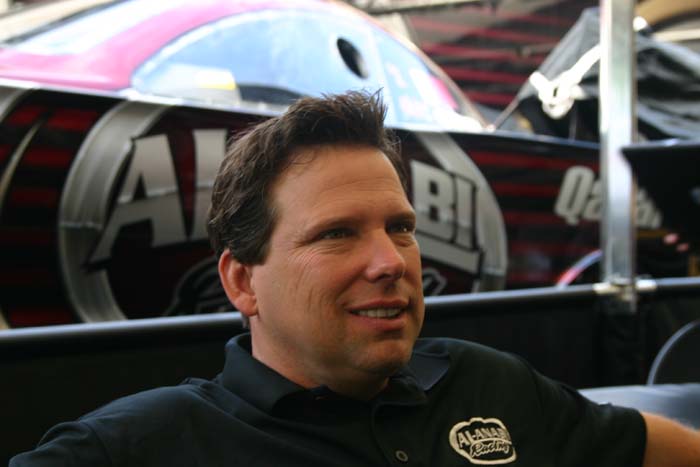
Funny Car racer Del Worsham borrowed a set of Head's front brakes in Englishtown out of safety concerns. The unit didn't match up with his existing system but with some modifications to the A-arm system could be in use this weekend in Norwalk.
“I still think it should be up to the driver and the team’s discretion,” Worsham said. “If there’s a better way out there, and can help you, we should have it on this car.”
But, then again, for Worsham, there is no performance issue since his car is not having weight issues as they routinely bolt on ballast to reach the minimum weight.
“Once we get them all dialed in, I am going to put them on the car where they will stay all season long,” Worsham said.
John Force Racing is another team which has tried the braking system. Just like Worsham, they plan to run them once they get the system to work with their chassis. Initially the heavy duty braking system added stress to the A-arms. They went back to the shop and crafted new A-arms and made adjustments to the chassis.
“When you get into situations where you have four races in a row, it’s hard to implement stuff like that. We are working in that direction,” said Dean Antonelli, co-crew chief on Ashley Force's Funny Car.
“More braking always provides you with peace of mind, and while we have good brakes on there now, most of the teams concentrate their braking capabilities on the rear,” explained Antonelli. “Even if you have the best brakes, and you get in your own oil, it doesn’t matter. You don’t have those issues with the front brakes. “
Antonelli confirmed the typical John Force Racing car is 35 pounds over the weight minimum due to safety additions.
In the end, if the brakes save just one life, it’s worth its weight in gold. Just being a part of safety innovation would fulfill a lifelong goal for Head.
“I’d feel a great deal of satisfaction,” admitted Head, whose performance innovations were adopted by many teams over the last two decades. “I used to love to innovate and rightfully so, in that area, we’ve been boxed in. I think the sanctioning body didn’t necessarily do bad in boxing us in with performance, but we sure haven’t been boxed in with safety and they’ve done a good job at it, short of the wheel restraints … and that’s a whole another story.
“If my safety innovations, becomes the standard on these cars out here, and they save a life, then it will be something to be very proud of.”
Worsham agrees.
“I think is just a matter of taking [safety] to the next level,” Worsham said. “Just to think, if we had declared the 1991 car as the be-all, end-all safest chassis, we wouldn’t have the car we have today. We have a safe car today. Safety is always a work in progress.”
And for Jim Head, he’s progressing in the direction of greater safety.
Categories:




































